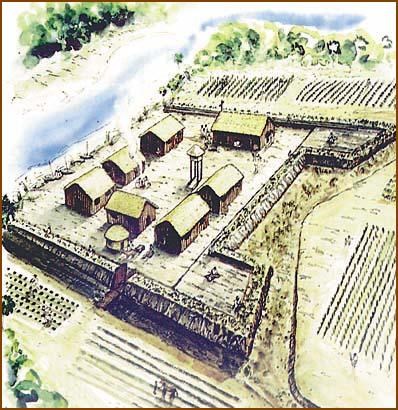
By the late 1600s, black slaves had learned that they could escape their British masters and seek freedom and asylum in Spanish Florida if they embraced Catholicism and pledged to serve the Spanish Crown. In 1738 Florida Governor Manuel de Montiano granted these blacks a plot of land about two miles north of St. Augustine where they could build their own settlement and fort. The fort was described as an earthen-walled fort with Indian-type thatched huts, and the community housed thirty-eight men and their families, and estimated population of about one hundred people. They adopted Spanish names and Spanish culture with an African flavor. This was the beginning of Fort Mosé, or "Gracia Real de Santa Teresa de Mosé," North America's first free legally sanctioned Black community. Fort Mosé (pronounced moe-say) was located two miles north of the Castillo de San Marcos near the marsh on Mosé Creek, a tributary of the Tolomato River which flows south into Matanzas Bay. Trails from St. Augustine heading north and west passed near the fort. With these waterways and trails so near, this outpost was of strategic importance to the Spanish military. In exchange for the land, the black militia would help protect the northern approaches to St. Augustine. In 1740, during his attack against St. Augustine, British General James Oglethorpe captured Fort Mosé, and the inhabitants fled to St. Augustine. A few weeks later, however, Francisco Menendez, the leader of the Ft. Mosé community, led his forces in a surprise attack and a valiant re-taking of the fort. However, the battle had destroyed the fort, and it would not be re-built until 1752. The Africans continued to live there until 1763 when Spain gave up Florida to the British by treaty, at which time these people moved to Cuba with the rest of the citizens of St. Augustine. Abandoned and forgotten, Fort Mosé slowly fell into ruin, and then disappeared. When Florida became a territory of the United States in 1821 and then a southern state in 1845, there was little interest in researching black history. Evidence of the first free black settlement remained buried under the marsh until the middle of the twentieth century when researchers began uncovering the story of Fort Mosé and the Africans' contributions to St. Augustine. Eventually, an archaeological dig in 1986 uncovered the site of the fort as well as fragments of items used in the inhabitants' daily lives such as pottery and religious artifacts. The state of Florida was able to acquire the 24-acre site and now administers it through Anastasia State Recreation Area. In 1994 Fort Mosé was designated a National Historic Landmark. Since it is located in the marsh, there is presently no public access to the actual site of the fort. However, there is a covered picnic pavilion, a visitor center with interpretive exhibits and a boardwalk trail into the marsh. Click here more information. Fort Mosé is located about 2 ½ miles north of the St. Augustine Historic District just off Saratoga Street east of US 1 just north of the coquina "Ponce de Leon" gates (just past the Winn-Dixie shopping center). See also: Fort Mosé - Gracia Real de Santa Teresa de Mosé: A Free Black Town in Spanish Colonial Florida by Jane Landers, St. Augustine Historical Society, 1962 Fort Mosé - Colonial America's Black Fortress of Freedom by Kathleen Deagan and Darcie MacMahon, University Press of Florida, 1995 |
Last updated: April 13, 2020
